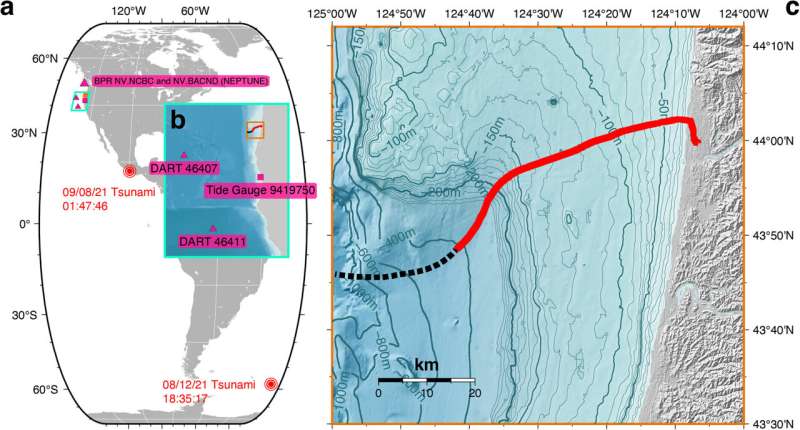This article has been reviewed according to Science X's editorial process and policies. Editors have highlighted the following attributes while ensuring the content's credibility:
fact-checked
peer-reviewed publication
trusted source
proofread
Fiber optic cables are an effective way to detect tsunamis, researchers show

Fiber optic cables that line ocean floors could provide a less expensive, more comprehensive alternative to the current buoys that act as early warning systems for tsunamis, says a University of Michigan researcher.
A system called DART, or Deep-ocean Assessment and Reporting of Tsunamis, is composed of specialized buoys that monitor for tsunamis. Overseen by the National Oceanic and Atmospheric Administration, the buoys cost about $500,000 to install, with another $300,000 annually for upkeep. Thirty-two detection buoys dot the perimeter of the Pacific Ocean, resulting in millions of dollars per year in upkeep—costly, but vital upkeep.
Now, U-M seismologist Zack Spica and colleagues at California Institute of Technology have used a technique called distributed acoustic sensing, or DAS, to tap into a cheaper, more ubiquitous way to keep tabs on the natural disasters: the roughly 1 million miles of fiber optic cables that crisscross ocean floors.
"Telecommunication companies have been laying down these fiber optic cables for the last 30 years, and have spent hundreds of billions of dollars to do that," said Spica, U-M assistant professor of Earth and environmental sciences. "Now, thanks to advanced photonics and great computing power, we can turn fiber optic cables into super dense, high fidelity arrays of sensors."
Tsunamis are a series of massive waves triggered by sudden displacement of ocean water, most typically caused by the sudden ground motion of the sea floor. Tsunamis can be minor, or they can be devastating, such as 2004's Indian Ocean tsunami, which killed nearly 228,000 people.
In a study published in Geophysical Research Letters, Spica and colleagues show that fiber optic cables can be used as an early tsunami warning system.
"Unlike earthquakes that happen suddenly and are hardly avoidable, even though some early warning systems exist, tsunamis generally take more time to build up and reach the coast," Spica said. "This means that early warning systems are more efficient for tsunamis. Yet, what is hard is to assess the magnitude of a tsunami before it reaches the coast. Therefore, offshore instrumentation is needed, which is costly and hard to maintain."
Over the previous five years, Spica and his fellow researchers installed DAS interrogator units in fiber optic telecommunication companies in Alaska, Japan, Spain and Lake Ontario that tap into underwater fiber optic cables. Using one of the devices placed in Florence, Oregon, the team was able to detect a tsunami that originated in an island chain nearly 1,300 miles east of the tip of South America.
"This was a major earthquake in the Sandwich Islands that generated a large tsunami. It wasn't even in the same ocean as the cable and device on which we detected it," Spica said. "By the time the tsunami arrived in Oregon and Alaska, it had a run-off of only a few centimeters, which didn't produce any damage."
The DAS technique works by monitoring photons—particles of light—that travel through fiber optic cables. As light travels in a wave through the cables, some photons are refracted back to the beginning of the cable. These photons are refracted backward and at a given time, the amount of light that returns to the interrogator is proportional to the deformation along the cable.
Researchers initially used these cables to detect earthquakes. Earthquakes release a massive amount of energy in a very short amount of time. The big question, Spica said, was whether the cables could detect the much more subtle movement of tsunamis. The period between the crest of waves in a tsunami can be incredibly long—up to tens of minutes and several miles between the crest of waves.
"Earthquakes generally have much higher energy and shake very quickly, while tsunamis have very broad waves," Spica said. "So the question was, can we use these techniques to monitor very long period waves?"
The researchers are unsure what characteristic of the tsunami causes a change in the fiber optic cables. Pressure-induced deformation from extra water on top of the cables could cause fibers within them to stretch, changing how photons are refracted. Temperature could cause a similar change, but Spica says more research is needed to determine exactly how the fibers are impacted.
The DAS system could offer telecommunication companies an alternate way of using fiber optic cables in the future, as satellites replace cables as a primary route of delivering internet. Spica says the cables could be used for military surveillance, boat tracking, measuring internal waves, tracking ocean temperatures and for research on climate change.
"These telecommunication companies have heard about this sensing, but it's still very early," Spica said. "But if we think large, if we think big over the next 15 years, they should probably try to reinvest in their own infrastructure."
This study builds on previous research Spica conducted to determine whether fiber optics could detect ground motions from earthquakes. Next, Spica says software needs to be developed to transcribe information for tsunami detection from fiber optic cables in real time.
More information: Han Xiao et al, Detection of Earthquake Infragravity and Tsunami Waves With Underwater Distributed Acoustic Sensing, Geophysical Research Letters (2024). DOI: 10.1029/2023GL106767




















